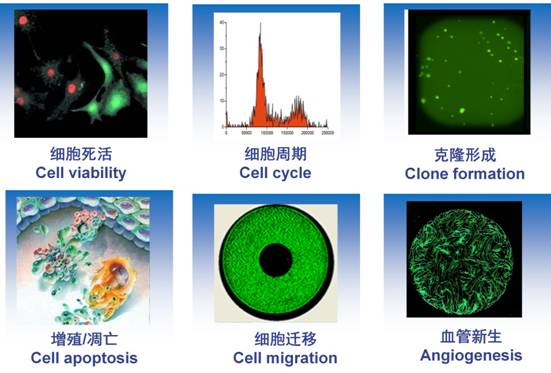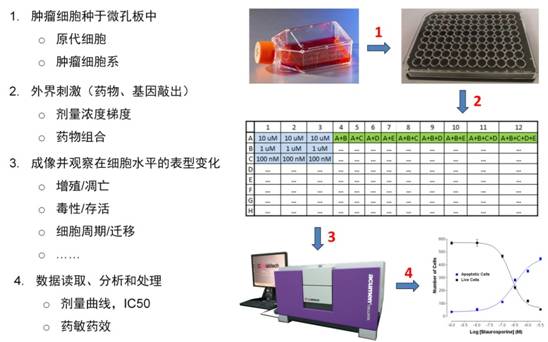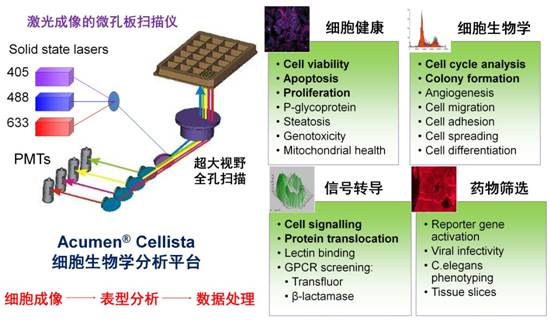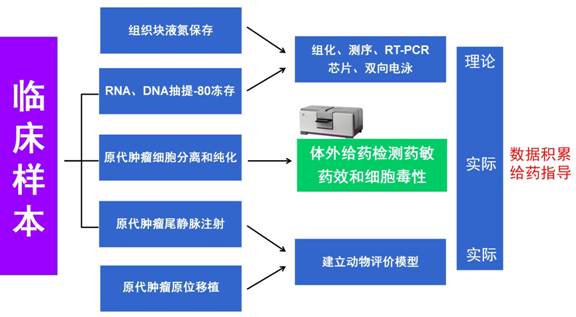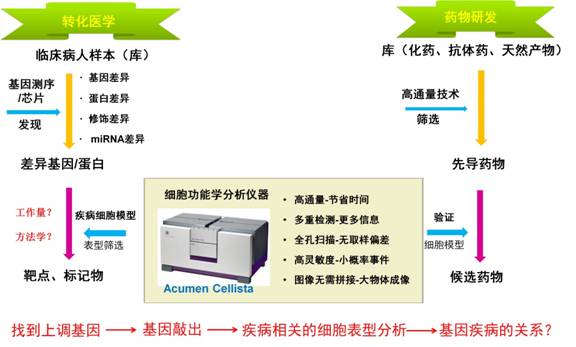I. Overview:
Translational medical research based on biological sample libraries is inseparable from functional studies at the cellular level. As the smallest structural unit of human function, cells have always been an important target in biological and medical research. At present, whether it is the basic research of mechanism mechanism or the clinical research of diagnosis and treatment, it is inseparable from the analysis and verification of cell level. Therefore, the establishment of a phenotypic analysis model at the cellular level is of great significance for the study of accelerated translational medicine.
Second, what is the phenotypic analysis of cells?
For oncology studies, common cell phenotypes include proliferation, apoptosis, migration, differentiation, angiogenesis, and colony formation. Cell phenotypic analysis studies and evaluates drug toxicity and drug susceptibility by comparing changes in cells between normal and patient, control and drug-treated groups, or pre- and post-operative.
Third, how to perform cell phenotypic analysis?
The flow of cell phenotypic analysis is shown in the figure below. The ultimate goal of translational medicine is for the treatment and diagnosis of diseases, and cell phenotypic analysis aims to provide more intuitive and abundant verification data at the cellular level for the target of clinical drug treatment and the discovery of diagnostic markers.
Four, Acumen multi-functional cell biology platform: designed for cell phenotype analysis design
As a laser scanning microplate cell analyzer, Acumen ® Cellista is widely used in functional experiments at various cell levels, including cell health analysis (proliferation, apoptosis, and toxicity), cell biology (migration, differentiation, and cell cycle). ), signal transduction (protein kinases, GPCRs), and the discovery of lead compounds in high-content drug screening, target demonstration, functional genomics, metabolomics, and toxicology studies.
V. Acumen 's exploration in translational medicine research based on biological sample library
Strategy 1, drug susceptibility and toxicity testing on primary cells of patients
The various cell functional experiments listed above have been widely demonstrated to have excellent applications in Acumen. However, for the study of translational medicine, in order to ensure greater relevance to the clinic, researchers are more eager to seek evaluations related to efficacy and toxicity in primary cells isolated from patient tissues. To this end, Tengquan has been exploring this field and has achieved certain results. Among them, some customers of Tengquan have cooperated with the hospital to obtain clinical samples, and some are used for immunohistochemical analysis and sequencing. After another separation and purification, the drug is directly administered on the primary cells to observe the drug susceptibility drugs. The effect is the Acumen multi-functional cell biology analysis platform.
Strategy 2, target verification after biochip sequencing (using drug development strategies)
Chip technology has a long history in the screening of disease markers and the discovery of drug targets. Screening for mutations, deletions, and expression of DNA, mRNA, and protein levels in clinical samples has led to the discovery of a variety of disease-related genes. The short-term, low-cost screening of chip technology enables the effective use of clinical case samples, but due to the intricacies of life systems and signaling pathways, such screening often leads to more candidate targets. How to verify these targets and correlate with disease phenotypes is a problem that plagues many clinical researchers.
As an effective, widely accepted and easily quantifiable method, RNAi provides a direct causal link between individual genes and their functionally deficient phenotypes, allowing direct identification and identification of human gene function. The combination of chip technology and small siRNA library to give full play to their respective advantages, and supporting a highly efficient multi-functional detection platform at the cellular level, provides a new, rapid, objective and comprehensive screening of markers and drug targets based on translational medicine and sample libraries. solution. For example, the German Max Planck Cell Biology uses siRNA libraries to screen for genes related to the cell cycle. For related literature, please contact us.
Sixth, the brand introduction :
Acumen laser scanning technology comes from TTP Labtech, a subsidiary of TTP Group, Europe's largest independent technology development and innovation group. TTP Labtech is a wholly owned subsidiary of the TTP Group, specializing in the development, production and innovation of precision instruments and equipment for life science research and development. As the office of TTP Labtech in China, Shanghai Tengquan has been developing its full range of products in the Chinese market since its entry into the Chinese market in 2007. It firmly believes that China's production, R&D resources and TTPGroup's innovative capabilities are highly complementary.
If you are interested in the above instruments, please contact us:
Tengquan Life Technology
Add: 4th Floor, Building 21, 88 Darwin Road, Pudong New Area, Shanghai
Tel: 021-51088608
Email:
Pressure Compensation Emitter Automatic Assembly Machine And Products
Shandong Chunyu Water-saving Irrigation Equipment Co., Ltd., founded in 2011, is located in Laiwu High-tech Zone, Jinan City. It is a high-tech enterprise focusing on innovative and efficient emitter mold manufacturing and emitter product research and development and production. After nearly ten years of innovation and development, it is the invisible champion enterprise in Shandong Province, and now it is in a leading position in this field in China.
Spring rain people-oriented, build talent highland. At present, the company has 16 high, fine and advanced technical personnel, and cooperates with a number of scientific research institutes, forming a mold design, emitter testing, flow testing and other professional technical personnel team. In recent years, it has obtained 3 invention patents, 33 utility model patents and 3 patent awards. In 2019, it was identified as an intellectual property advantage enterprise in Jinan. It has undertaken 4 provincial science and technology innovation projects and won 2 second prizes of Shandong Science and Technology Progress Award. The company has built Jinan drip emitter mold engineering technology research center, the company has a slow wire cutting, CNC machining center, precision EDM machine, 3D projection measuring instrument, CNC engraving, laser engraving and other advanced processing equipment. Mature technology and rich experience support the excellent quality of Chunyu. Spring Rain pays attention to every link of production, implements 8S management, strictly controls the quality of products at the beginning, the middle and the end, and forms the seamless link of production management. The company has independently researched and developed flat emitter molds with full hot runner, cylindrical emitter molds with full hot runner and other products. With excellent quality, competitive price and good after-sales service, the company is well known at home and abroad, and has been sold well in Egypt, India, Iran, Turkey, Saudi Arabia, the United States and other countries.
With the vision of "building a global professional emitter mold supplier" and the mission of "providing solutions for efficient and innovative production of global water-saving irrigation enterprises", the company takes "scientific and technological innovation to scale new heights; Keep improving, the pursuit of excellence; Honesty and trustworthiness, win-win cooperation "for the values of the enterprise. For the construction of water - saving and resource-saving society to make a positive contribution.
Hose Reel Irrigation Machine,Automatic Emitter Assembly Machine,Agriculture Irrigation Equipment,Automatic Irrigation Equipment
Shandong Spring Rain Water Saving Irrigation Equipment Co.,Ltd. , https://www.drippermould.com
